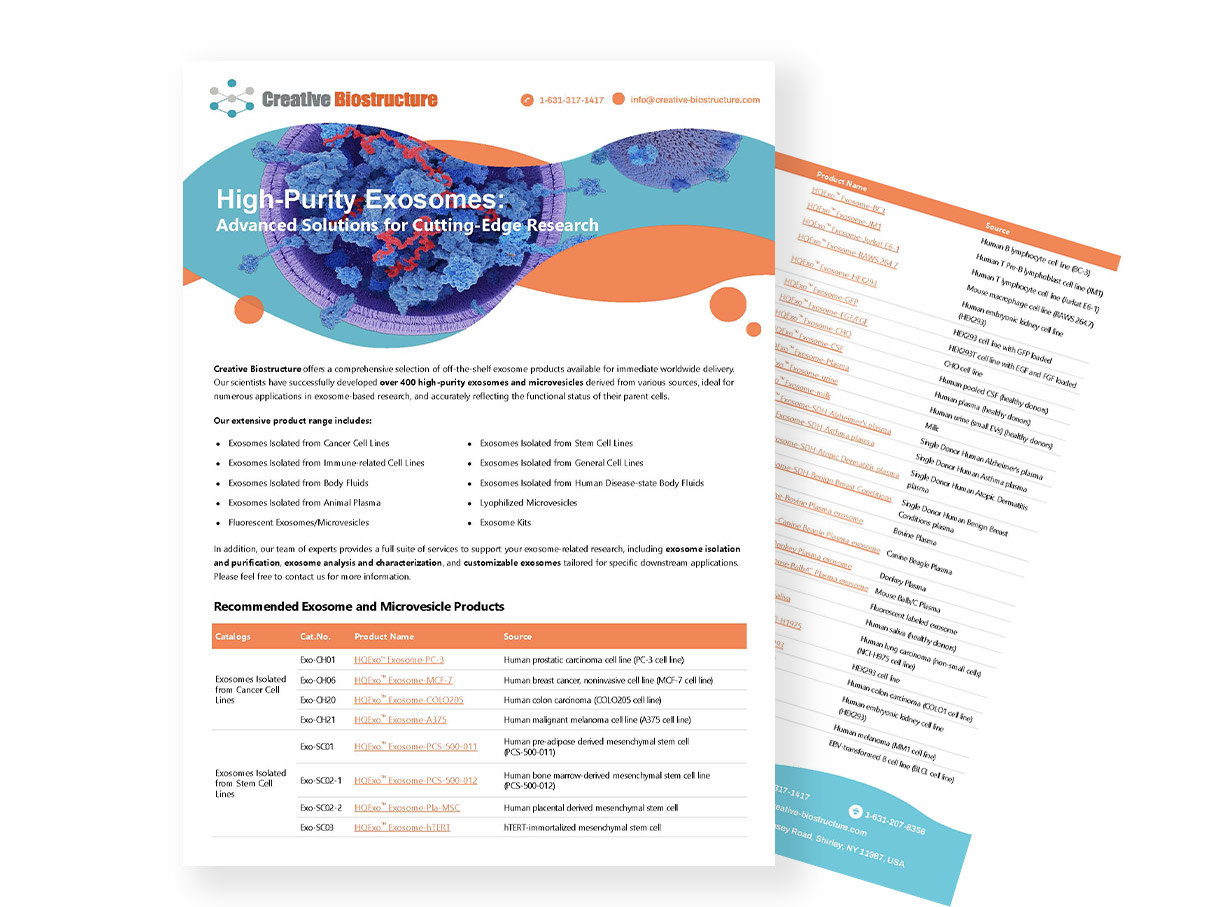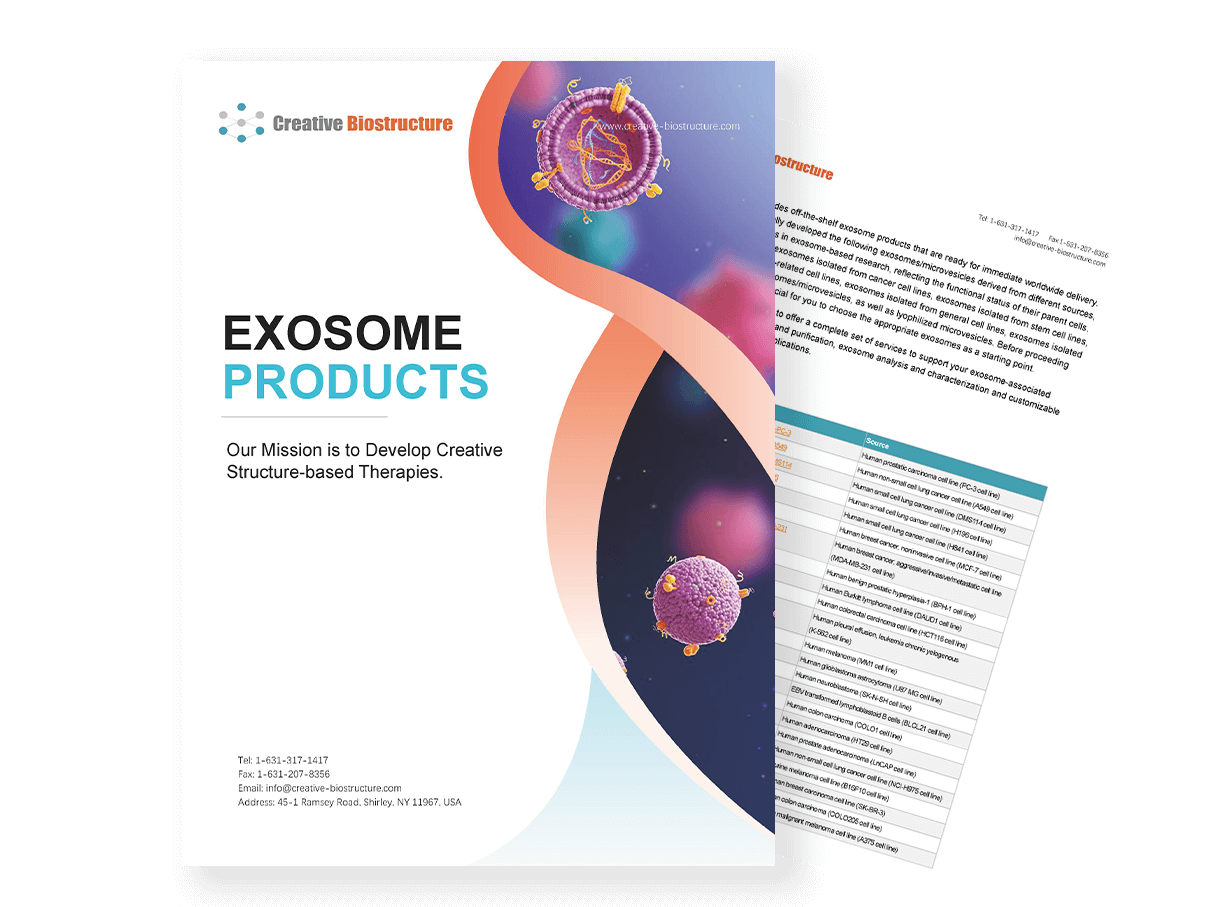Exosomes Isolated from Plant
Creative Biostructure offers exosomes isolated from plant sources, providing researchers with a powerful and natural tool to advance scientific discovery. Our plant-derived exosomes serve as a standard for cutting-edge research in areas such as drug delivery, immune modulation, disease research, and more. They are suitable for a range of research applications including WB, ELISA, FACS, and more. In addition to these exosomes that are used as a standard for research, we also offer plant-based exosomes that can be used for downstream production applications.
Product List
Plant Exosomes: Unveiling Their Unique Role in Intercellular Communication and Research
The discovery of exosomes in plants has extended the role of exosomes in intercellular communication and signaling pathways. The similarities between the plant exosomes (plant exosome-like nanoparticles (PELNs)) and their mammalian relatives have been highlighted in recent years. Exosomes from plants are formed by the same process as those in animal cells—the invasion of the plasma membrane, then they fused with the plasma membrane and released from the cell.
Exosomes of plants are different species to species and developmental stage to developmental stage. They are rich in proteins (enzymes, transcription factors, membrane proteins) and various RNAs, including messenger RNAs (mRNAs), microRNAs (miRNAs), and small interfering RNAs (siRNAs). And their lipid composition—phospholipids, glycolipids and sterols—also describes their cellular origin and are essential for their structural integrity and function.
Exosomes produced by plants are known to have a range of physiological functions, from stress-tolerance to resistance to phytopathogens and uptake of nutrients. Plant exosomes, for example, have been reported to contain stress-responsive proteins and RNAs that allow the plant to compensate for perturbations in the environment. Plant exosomes also coordinate the contact with microbes, which means that they can influence symbiosis or antimicrobial defenses.
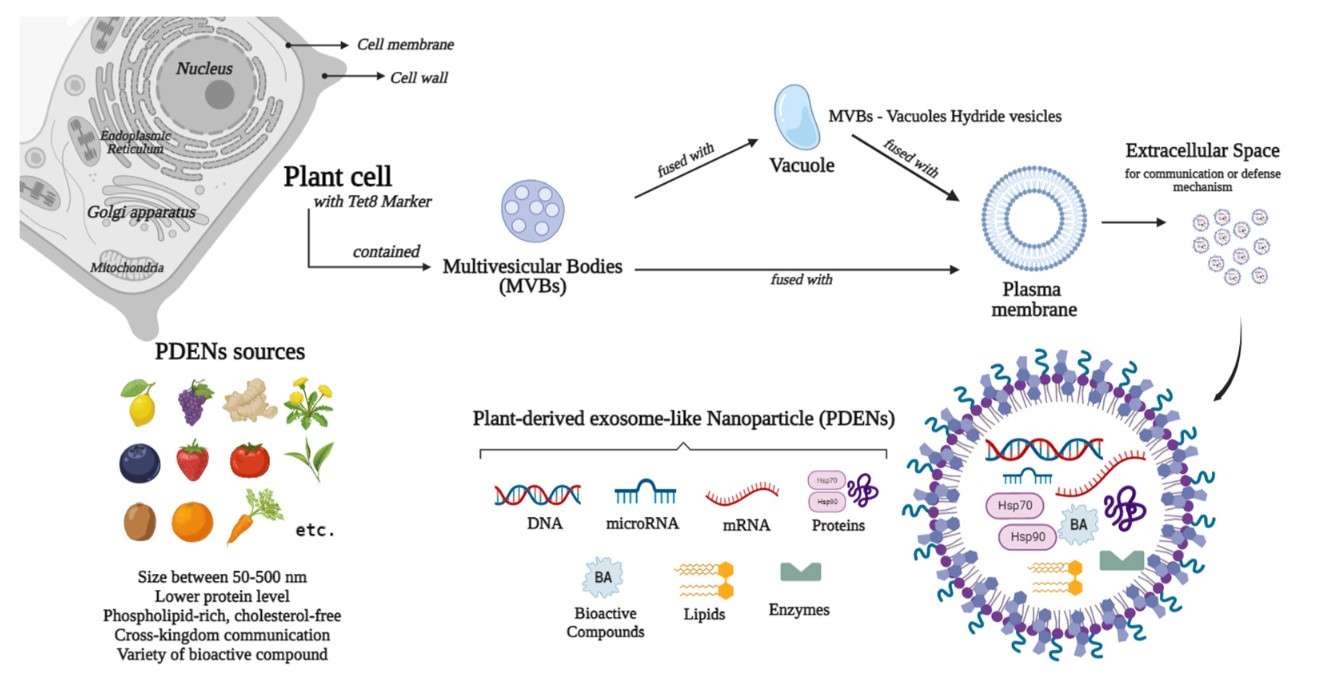 Figure 1. Sources, biogenesis, and contents of plant-derived exosomes. (Sarasati A, et al., 2023)
Figure 1. Sources, biogenesis, and contents of plant-derived exosomes. (Sarasati A, et al., 2023)
The plant exosomes are isolated using sophisticated techniques such as ultracentrifugation, polymer precipitation, and immunoaffinity. These exosomes retain their full bioactive potential, providing a reliable source of natural molecules for a variety of research purposes. The plant exosomes are isolated using sophisticated techniques such as ultracentrifugation, polymer precipitation and immunoaffinity. These exosomes retain their full bioactive potential, providing a reliable source of natural molecules for a variety of research purposes. In particular, plant exosomes often contain molecules such as small RNAs (including microRNAs), antioxidants, polyphenols, lipids, and proteins—key components valuable in the study of gene regulation, immune modulation, and therapeutic applications.
Research Directions in Plant-Derived Exosomes
Understanding Plant Exosome Communication
Exosomes isolated from plants are essential for research aimed at understanding how plant exosomes mediate intercellular communication and interact with their environment. This includes exploring how they influence relationships with beneficial microbes, support plant immunity and provide defense against pathogens, all of which are essential for disease resistance and environmental adaptability.
Characterizing Exosome Composition
Scientists are analyzing the molecular composition of plant exosomes in detail, including their proteins, lipids and RNAs. The goal is to understand how these components vary among plant species, developmental stages, and environmental conditions, and how these variations affect their biological functions and potential applications.
Studying Stress Responses
Plant exosomes are being studied for their role in enabling plants to adapt to environmental stress. These vesicles carry stress-responsive proteins and small RNAs that help plants withstand challenges such as drought, salinity, and extreme temperatures. The knowledge gained could lead to strategies to increase the resilience and productivity of crops.
Developing Nanocarriers for Drug Delivery
The use of plant-derived exosomes as natural nanocarriers for drug delivery is gaining attention due to their biocompatibility and bioactive properties. These exosomes are ideal for transporting therapeutic molecules, antioxidants and bioactive compounds across biological barriers in both human and veterinary medicine.
Enhancing Genetic Engineering
Plant exosomes have the potential to be innovative vectors for genetic engineering. Their ability to deliver small RNAs, such as microRNAs, to regulate gene expression opens up new opportunities for crop improvement, gene-editing technologies and precision agriculture.
Case Studies
Case Study 1: Protective Effects of Ginger Exosome-Like Nanoparticles Against Periodontal Pathogens
The Sundaram team focus here is to examine whether plant exosome-like nanoparticles (PELNs)—ginger exosome-like nanoparticles (GELNs)—can protect mammalian hosts from infection. They find that GELNs are actively recruited by the periodontal pathogen Porphyromonas gingivalis via a phosphatidic acid (PA)-dependent mechanism with hemin-binding protein 35 (HBP35) on the surface of the bacteria. By interacting with it, GELN cargo molecules, such as PA and microRNAs (miRs), significantly reduce the pathogenic mechanisms of P. gingivalis by targeting multiple pathogenic factors simultaneously. The study also demonstrates the therapeutic potential of edible PELNs for preventing or treating chronic periodontitis in a mouse model. It also shows the promising use of plant-derived nanoparticles to attack bacterial infections.
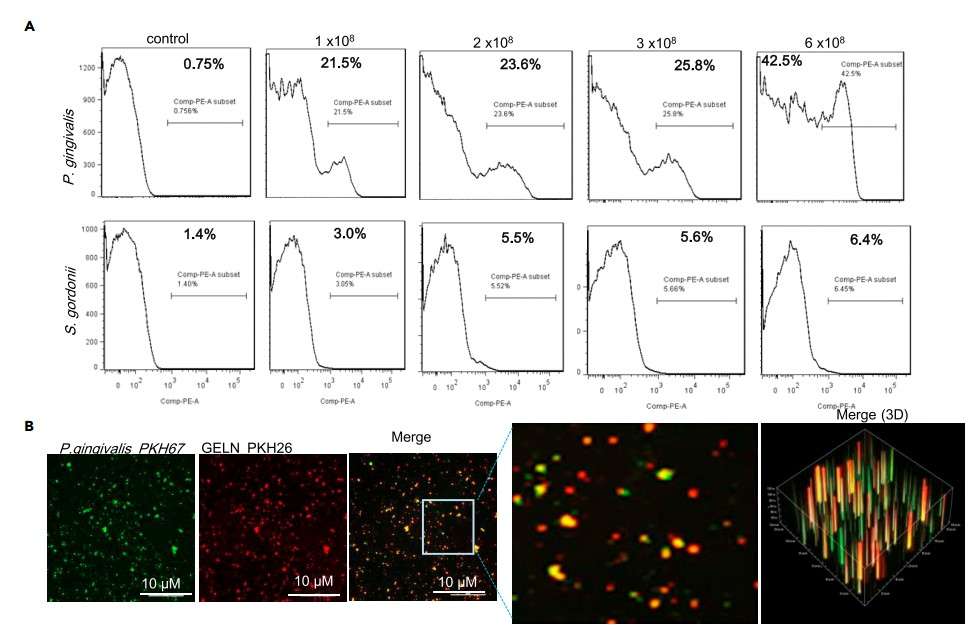 Figure 2. Ginger exosome-like nanoparticles (GELNs) selectively inhibit growth of the pathogenic P. gingivalis but not the commensal S. gordonii. (A) P. gingivalis and S. gordonii were incubated with different concentrations (0 - 6.0 x 108 particles/mL) of PKH26-labeled GELNs for 1 h in an anaerobic chamber. GELN uptake by P. gingivalis and S. gordonii was quantified by flow cytometry. (B) P. gingivalis and GELNs were labeled with fluorescent dyes PKH67 and PKH26, respectively. Then, P. gingivalis and GELNs were incubated at 37 °C for 1 h in anaerobic chamber and fluorescence images were taken by confocal microscopy. (Sundaram K, et al., 2019)
Figure 2. Ginger exosome-like nanoparticles (GELNs) selectively inhibit growth of the pathogenic P. gingivalis but not the commensal S. gordonii. (A) P. gingivalis and S. gordonii were incubated with different concentrations (0 - 6.0 x 108 particles/mL) of PKH26-labeled GELNs for 1 h in an anaerobic chamber. GELN uptake by P. gingivalis and S. gordonii was quantified by flow cytometry. (B) P. gingivalis and GELNs were labeled with fluorescent dyes PKH67 and PKH26, respectively. Then, P. gingivalis and GELNs were incubated at 37 °C for 1 h in anaerobic chamber and fluorescence images were taken by confocal microscopy. (Sundaram K, et al., 2019)
Case Study 2: Green Onion-Derived Exosome-like Nanoparticles Prevent Ferroptotic Cell Death Triggered by Glutamate: Implication for GPX4 Expression
This study of green onion-derived exosome-like nanoparticles (GDENs) demonstrated their ability to protect HT-22 mouse hippocampal cells from glutamate-induced ferroptotic cell death. Isolated using polyethylene glycol, GDENs had a diameter of 167.4 nm and a zeta potential of -16.06 mV. GDEN effectively reduced intracellular iron accumulation, inhibited Ca²⁺ influx and lipid peroxidation, and modulated proteins associated with iron metabolism. In addition, GDEN upregulated glutathione peroxidase 4 and enhanced glutathione synthesis, providing robust antioxidant support. These findings suggest that GDENs are promising natural bioactives for combating neuronal cell death and advancing the treatment of neuronal disorders.
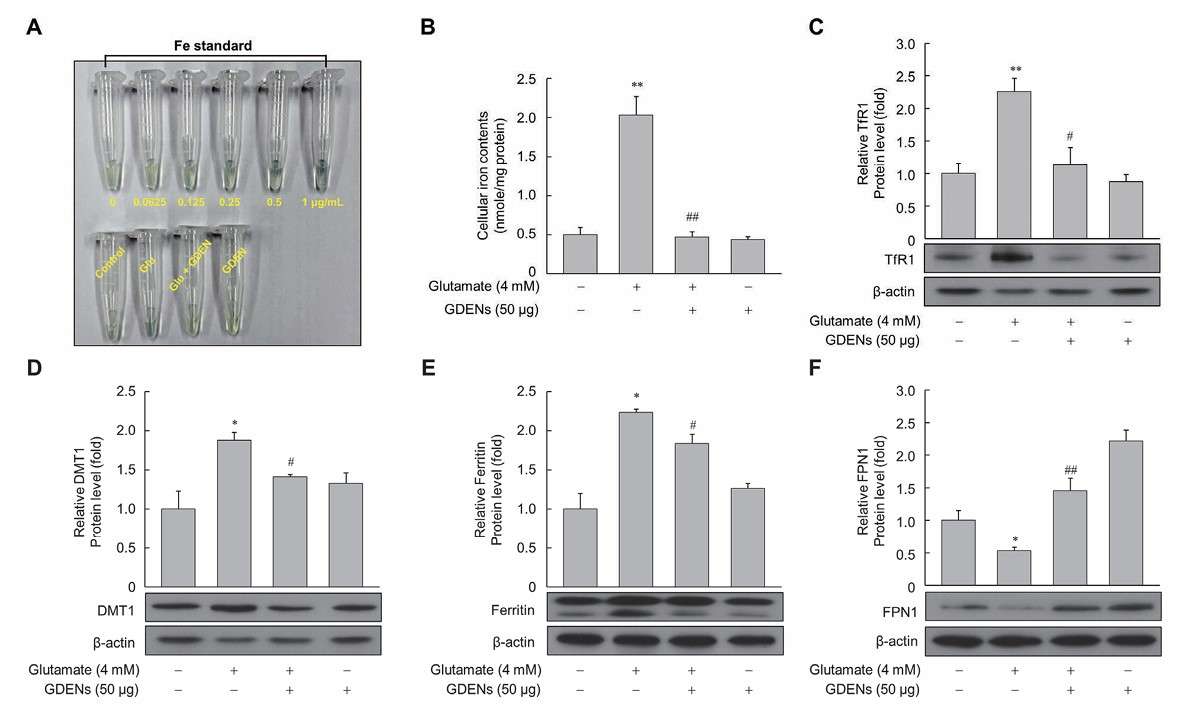 Figure 3. GDENs reduce intracellular iron levels by regulating the iron metabolism-related protein expression. (A–F) HT-22 cells were exposed to 4 mM glutamate for 16 h, with or without the addition of 50 µg GDENs. Intracellular iron levels were measured using the ferene-based colorimetric method (A, B). Protein expression was evaluated via Western blot (C–F), and β-actin was used as an internal control. Results are presented as mean ± SE (n = 3). * p < 0.05, ** p < 0.01 compared to the control group; # p < 0.05, ## p < 0.01 compared to the glutamate-treated group. (Yoon et al., 2024)
Figure 3. GDENs reduce intracellular iron levels by regulating the iron metabolism-related protein expression. (A–F) HT-22 cells were exposed to 4 mM glutamate for 16 h, with or without the addition of 50 µg GDENs. Intracellular iron levels were measured using the ferene-based colorimetric method (A, B). Protein expression was evaluated via Western blot (C–F), and β-actin was used as an internal control. Results are presented as mean ± SE (n = 3). * p < 0.05, ** p < 0.01 compared to the control group; # p < 0.05, ## p < 0.01 compared to the glutamate-treated group. (Yoon et al., 2024)
Product Advantages
- Natural Composition: Plant exosomes contain bioactive molecules such as proteins, lipids, microRNAs, and antioxidants, making them a valuable resource for biological research.
- Bioactive Cargo: Rich in compounds such as polyphenols, omega fatty acids, and small RNAs, these exosomes can influence various biological processes and are important in research on drug delivery, immune modulation, and more.
- Sustainability: Sourced from renewable plant materials, these exosomes provide an eco-friendly and sustainable alternative to synthetic or animal-derived nanocarriers.
- High Purity and Consistency: Our exosome isolation process ensures high purity and consistency in every batch, providing reliable results as standard control in your research.
Resources
Frequently Asked Questions
-
What's the difference between plant exosomes and animal exosomes?
Exosomes derived from plants, or exosome nanoparticles—these nanosized extracellular molecules from plants. Similar to exosomes from animals, they're packed with bioactive molecules such as proteins, lipids and microRNAs. But the plant-derived exosomes are more sustainable and biocompatible than the animal-derived exosomes—that is, less side-effects and more therapeutic benefits.
-
Where do your plant exosomes come from and how are they isolated?
Our plant-derived exosomes come from various edible plants and are purified and bioactive according to the cutting-edge extraction technology. We use ultracentrifugation and size-exclusion chromatography to isolate and purify the exosomes effectively
-
What are the key advantages of plant exosomes in research?
Plant exosomes offer a natural, sustainable, and low-immunogenic alternative to synthetic or animal-derived nanocarriers. They are rich in bioactive molecules and can be used for drug delivery, immune modulation, regenerative medicine, and more.
-
Do you offer additional plant-derived exosomes?
Yes, beyond the research-grade exosomes listed above, we also provide a range of plant-based exosomes designed for downstream applications. Please note that these additional exosomes are not research-grade but are ideal for various practical uses.
At Creative Biostructure, we are committed to advancing your research with our high-quality, innovative plant-derived exosomes. Contact us for access to exosome standards designed for precise quantitative calibration in biological samples. These standards ensure experimental consistency, improve data interpretation, support regulatory compliance, and enhance your research applications.
References
- Akao Y, Kuranaga Y, Heishima K, et al. Plant hvu-MIR168-3p enhances expression of glucose transporter 1 (SLC2A1) in human cells by silencing genes related to mitochondrial electron transport chain complex I. The Journal of Nutritional Biochemistry. 2022;101:108922.
- Sarasati A, Syahruddin MH, Nuryanti A, et al. Plant-derived exosome-like nanoparticles for biomedical applications and regenerative therapy. Biomedicines. 2023;11(4):1053.
- Sundaram K, Miller DP, Kumar A, et al. Plant-derived exosomal nanoparticles inhibit pathogenicity of porphyromonas gingivalis. iScience. 2019;21:308-327.
- Yi Q, Xu Z, Thakur A, et al. Current understanding of plant-derived exosome-like nanoparticles in regulating the inflammatory response and immune system microenvironment. Pharmacological Research. 2023;190:106733.
- Yoon HJ, Won JP, Lee HG, Seo HG. Green onion-derived exosome-like nanoparticles prevent ferroptotic cell death triggered by glutamate: implication for GPX4 expression. Nutrients. 2024;16(19):3257.
